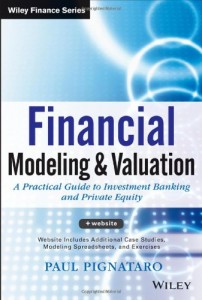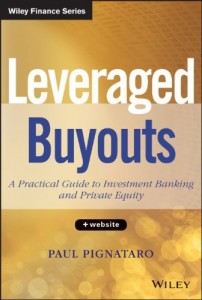Investment Banking Certificate
Course List

Financial Statements, Projections and Analysis I
Course 2700
Overview
Financial Modeling is the fundamental building block of analysis in Investment Banking. We will take a look at a Fortune 500 company and analyze its financial standing, building a complete financial model as done by Wall Street Analysts.
Required Textbook
Financial Modeling and Valuation: A Practical Guide to Investment Banking and Private Equity (Wiley Finance), Paul Pignataro
 Written by the Founder and CEO of the prestigious New York School of Investment Banking, this book schools you in the fundamental tools for accurately assessing the soundness of a stock investment. Built around a full-length case study of Wal-Mart, it shows you how to perform an in-depth analysis of that company’s financial standing, walking you through all the steps of developing a sophisticated financial model as done by professional Wall Street analysts. You will construct a full scale financial model and valuation step-by-step as you page through the book.
Written by the Founder and CEO of the prestigious New York School of Investment Banking, this book schools you in the fundamental tools for accurately assessing the soundness of a stock investment. Built around a full-length case study of Wal-Mart, it shows you how to perform an in-depth analysis of that company’s financial standing, walking you through all the steps of developing a sophisticated financial model as done by professional Wall Street analysts. You will construct a full scale financial model and valuation step-by-step as you page through the book.
- Overview and Introduction to Financial Modeling
- Excel Best Practices
- Accounting Fundamentals
- Interpreting a 10K
- SEC Filings
- Income Statement Flows and Projections including EPS and basic and diluted shares
- Income Statement Construction, Projections and Analysis
- Cash Flow Statement and Other Items Construction, Projections and Analysis
- Depreciation, Amortization, and Deferred Taxes Construction, Projections, Analysis and Management
- Working Capital Construction, Projections, Analysis and Management
- CAPEX flows and projections
- Balance Sheet Construction, Projections and Analysis
- Balance Sheet Balancing Techniques
- Debt and Interest Schedule Construction, Projections, Analysis and Management
- Understanding Circular References
- Preparing the Model for Utilization and Presentation – Scenarios, Cases, Toggles, and Data Tables
- Running and Testing Model Sensitivities – Raising $10MM Equity, Raising $10MM Debt
- Scenarios, EPS Estimates
Valuation and Analysis I
Course 3700
Overview
Valuation is crucial in investment banking and merger and acquisition analysis. How much is this entity worth? What is the appropriate price of this stock? We will take a look at the Fortune 500 company modeled in the Financial Statements course, analyze its financial standing, and determine if the stock is over or undervalued as done by Wall Street Analysts.
Required Textbook
Financial Modeling and Valuation: A Practical Guide to Investment Banking and Private Equity (Wiley Finance), Paul Pignataro
 Written by the Founder and CEO of the prestigious New York School of Investment Banking, this book schools you in
Written by the Founder and CEO of the prestigious New York School of Investment Banking, this book schools you in
the fundamental tools for accurately assessing the soundness of a stock investment. Built around a full-length case study of Wal-Mart, it shows you how to perform an in-depth analysis of that company’s financial standing, walking you through all the steps of developing a sophisticated financial model as done by professional Wall Street analysts. You will construct a full scale financial model and valuation step-by-step as you page through the book.
- Overview of Various Valuation Methodologies
- Equity Value Multiples vs. Enterprise Value Multiples
- Comparable Company Analysis
- Selecting Comparable Companies
- Gathering Public Information
- Calculating Market and Enterprise Values
- Normalizing Income Statement Data for Non-Recurring Items
- Calculating Latest Twelve Month Data (LTM)
- Calculating Multiples
- Creating a Target Valuation Range
- Precedent Transactions Analysis
- Selecting Relevant Transactions
- Control Premiums
- Sources of Public Information
- Discounted Cash Flow Analysis
- Calculating Weighted Average Cost of Capital (WACC)
- Derivation of an Calculation of Discounting Unlevered Free Cash Flows
- Estimating Terminal Value (Exit Multiple vs. Perpetuity Methods)
- Mid – Year vs. End of Year Discounting Methods
- Determining the Valuation Range Exercise: Adding DCF output to a 3-statement model for the case company
- Finalizing Valuation ranges
- Creating a “Football field” based on different valuation methodologies
- Comparing Our Valuation vs. Street Estimates
Mergers and Acquisitions I
Course 4700
Overview
Merger and Acquisitions is a key product in Investment Banking. We will take a look at the fundamental concepts of Mergers and Acquisitions, and understand how to effectively analyze a potential Merger or Acquisition. We will explore the process of looking for targets, including common practices. We will create an accretion dilution analysis, analyzing the fundamental impact of an acquisition, and further build a complete merger model as done by Wall Street Analysts.
Required Textbook
Mergers, Acquisitions, Restructurings, and Other Divestitures: A Practical Guide to Investment Banking and Private Equity (Wiley Finance), Paul Pignataro
 The history of mergers and acquisitions is arguably as long as the history of commerce itself. Over the
The history of mergers and acquisitions is arguably as long as the history of commerce itself. Over the
past century, waves of M&A activity have corresponded with equities markets and have changed with regulatory and market shifts. M&A activity is one major method of providing growth and value to both large and small corporations alike. The Wall Street coveted analysis of understanding the drivers leading to growth through M&A has remained a mystery, until now.
- Acquisition of Assets
- Divestitures
- Purposes and Uses
- Sources of Capital
- Assumptions
- Corporate Acquisitions (Acquisition of Equity, Purchase Accounting)
- Acquisition of Assets vs. Acquisitions of Equity (Stock)
- 338 h 10 Election
- Goodwill, Intangible Assets, Write-ups and Tax Implications of Each (Both GAAP and IFRS)
- Accretion / Dilution Analysis
- Credit Considerations
- Full-Scale Merger Modeling
- Pro-Forma Income Statement
- Pro-Forma Cash Flow Statement
- Balance Sheet Adjustments
- Pro-Forma Balance Sheet
- Depreciation and Deferred Taxes
- Working Capital
- Debt Schedule
- Outputs, Sensitivities, and Scenarios
- Corporate Divestitures
- Corporate Restructurings
- M&A Tax Accounting
Leveraged Buyouts I
Course 5700
Overview
A Leveraged Buyout is a fundamental, yet complex acquisition commonly used in the Private Equity industry. We will take a look at the fundamental concepts, benefits, and drawbacks of a Leveraged Buyout. We will understand how to effectively analyze a Leveraged Buyout, building a fully consolidated model. We will further analyze the fundamental impact of such a transaction and calculate the expected return to an investor. Lastly, we will spend time interpreting the variables and wide array of financing structures to understand how to maximize IRR.
Required Textbook
Leveraged Buyouts: A Practical Guide to Investment Banking and Private Equity (Wiley Finance), Paul Pignataro
 A Leveraged Buyout is a fundamental, yet complex acquisition commonly used in the Private Equity industry. We will take a look at the fundamental concepts, benefits, and drawbacks of a Leveraged Buyout. We will understand how to effectively analyze a Leveraged Buyout, building a fully consolidated model. We will further analyze the fundamental impact of such a transaction and calculate the expected return to an investor. Lastly, we will spend time interpreting the variables and wide array of financing structures to understand how to maximize IRR.
A Leveraged Buyout is a fundamental, yet complex acquisition commonly used in the Private Equity industry. We will take a look at the fundamental concepts, benefits, and drawbacks of a Leveraged Buyout. We will understand how to effectively analyze a Leveraged Buyout, building a fully consolidated model. We will further analyze the fundamental impact of such a transaction and calculate the expected return to an investor. Lastly, we will spend time interpreting the variables and wide array of financing structures to understand how to maximize IRR.
- Purposes and Uses – What is an LBO, What Makes a Good LBO Candidate?
- LBO Strategy and Concepts – Debt Paydown vs. Operational Growth
- Sources of Capital (Term Loans, Mezzanine Debt, PIK Securities)
- Goodwill
- Assumptions
- Purchase Price Consideration
- Quick Leveraged Buyout Analysis
- Full-Scale Leveraged Buyout Analysis
- Pro-Forma Income Statement
- Pro-Forma Cash Flow Statement
- Balance Sheet Adjustments
- Pro-Forma Balance Sheet
- Depreciation and Deferred Taxes
- Working Capital
- Debt Schedule
- Outputs, Sensitivities, and Scenarios
- Expected Returns – How to Maximize IRR
- Complex Securities
Mergers and Acquisitions II
Course 4800
Overview
Merger and Acquisitions is a key product in Investment Banking. We will build upon our core knowledge of Mergers and Acquisitions and take a look at more advanced concepts. We will explore various transaction structures, analyzing the financial, tax, and legal implications of each. We will re-create several landmark case studies, building complete merger models as a Wall Street Analyst would in a Bulge Bracket Investment Bank.
Required Textbook
Mergers, Acquisitions, Restructurings, and Other Divestitures: A Practical Guide to Investment Banking and Private Equity(Wiley Finance), Paul Pignataro
 The history of mergers and acquisitions is arguably as long as the history of commerce itself. Over the past century, waves of M&A activity have corresponded with equities markets and have changed with regulatory and market shifts. M&A activity is one major method of providing growth and value to both large and small corporations alike. The Wall Street coveted analysis of understanding the drivers leading to growth through M&A has remained a mystery, until now.
The history of mergers and acquisitions is arguably as long as the history of commerce itself. Over the past century, waves of M&A activity have corresponded with equities markets and have changed with regulatory and market shifts. M&A activity is one major method of providing growth and value to both large and small corporations alike. The Wall Street coveted analysis of understanding the drivers leading to growth through M&A has remained a mystery, until now.
- Advanced Mergers and Acquisitions
- Why Mergers and Acquisitions Happen
- Transaction Structures
- Transaction Key Players
- M&A Returns
- Corporate Takeover Market
- Hostile Takeovers
- Takeover Strategies
- Defense Strategies
- The M&A Process
- The Target Search and Screening Process
- Negotiations and Due Diligence
- Deal Intergration
- Deal Closing and Post-Closing Process
- Landmark Case Studies:
– Proctor &Gamble Acquisition of Gillette
– Kraft Acquisition of Cadbury
– Bank of America Acquisition of Merrill Lynch*Note these are just examples of the many cases we cover. We take Harvard and Kellogg cases and rebuild each scenario from scratch to simulate how a Wall Street analysts role in the deal.
Leveraged Buyouts II
Course 5800
Overview
A Leveraged Buyout is a fundamental, yet complex acquisition commonly used in the Private Equity industry. We will take a look at the fundamental concepts, benefits, and drawbacks of a Leveraged Buyout. We will understand how to effectively analyze a Leveraged Buyout, building a fully consolidated model. We will further analyze the fundamental impact of such a transaction and calculate the expected Valuing Privately Held Businesses return to an investor. Lastly, we will spend time interpreting the variables and wide array of financing structures to understand how to maximize IRR.
Required Textbook
Leveraged Buyouts: A Practical Guide to Investment Banking and Private Equity (Wiley Finance), Paul Pignataro
 A Leveraged Buyout is a fundamental, yet complex acquisition commonly used in the Private Equity industry. We will take a look at the fundamental concepts, benefits, and drawbacks of a Leveraged Buyout. We will understand how to effectively analyze a Leveraged Buyout, building a fully consolidated model. We will further analyze the fundamental impact of such a transaction and calculate the expected return to an investor. Lastly, we will spend time interpreting the variables and wide array of financing structures to understand how to maximize IRR.
A Leveraged Buyout is a fundamental, yet complex acquisition commonly used in the Private Equity industry. We will take a look at the fundamental concepts, benefits, and drawbacks of a Leveraged Buyout. We will understand how to effectively analyze a Leveraged Buyout, building a fully consolidated model. We will further analyze the fundamental impact of such a transaction and calculate the expected return to an investor. Lastly, we will spend time interpreting the variables and wide array of financing structures to understand how to maximize IRR.
- Advanced Leveraged Buyouts
- Due Diligence on Public and Privately Held Businesses
- Making Pre and Post Acquisition Adjustments
- Estimating WACC for Public and Privately Held Businesses
- LBO Strategy and Concepts – Debt Paydown vs. Operational Growth
- Sources of Capital (Term Loans, Mezzanine Debt, PIK Securities)
- Complex Securities
- Advanced LBO Deal Structures
- Maximizing Returns
- Landmark Case Studies:
– Berkshire Partners Buyout of Carters
– TPG Buyout of Billabong*Note these are just examples of the many cases we cover. We take Harvard and Kellogg cases and rebuild each scenario from scratch to simulate how a Wall Street analysts role in the deal.
